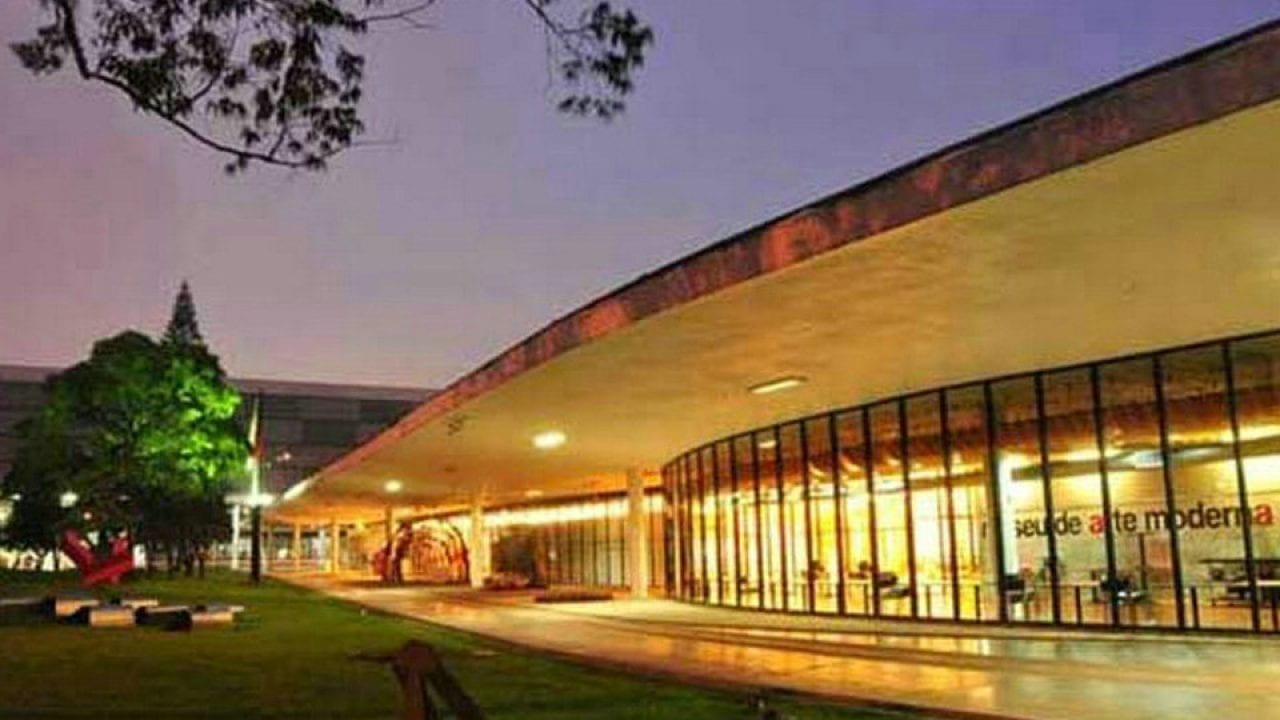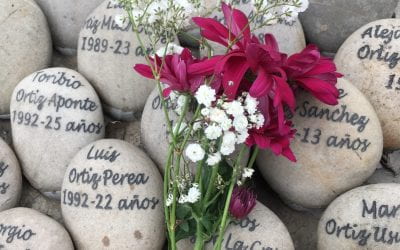When Decolonization Meets an Immovable Monument

Monumento às Bandeiras, outside Iberapuera Park, São Paulo.
It was early October 2013, well before the present wave of toppling statues in the name of decolonization gained momentum in the United States and the United Kingdom. A group of indigenous activists—protesting a proposed constitutional amendment (PEC 215) that would alter the way native lands are demarcated in Brazil—marched to the Monumento às Bandeiras, the most important sculptural landmark in São Paulo, and staged a demonstration, decking the monument with banners and raising a red flag that symbolized the blood of their ancestors. In the wake of those actions, other protestors— non-indigenous ones, according to some eyewitnesses—doused the statues with red paint and spray-painted slogans on the granite surface, including the phrase “bandeirantes assassinos.” This episode of politically fueled iconoclasm made headlines all over Brazil.
To understand the full significance of that act, the monument’s place in Brazilian and local cultural history needs firstly to be addressed. Inaugurated in 1953, as part of the city of São Paulo’s fourth centennial celebrations, Monumento às Bandeiras is part of the architectural, landscape and monumental complex around Ibirapuera Park. The park, stretching over 158 hectares (390 acres), is a popular and much loved site, comparable in its local importance to Central Park in New York or the Bosque de Chapultepec in Mexico City. It includes the pavilion where the world-famous São Paulo Biennial is held, as well as the Museu de Arte Moderna, the Museu Afro-Brasil and a 72-meter-high (236 feet) obelisk honoring the dead of the so-called Constitutionalist Revolution of 1932, a civil war that pitted the state of São Paulo against the federal government of Brazil. Much of the park’s architecture was designed by Oscar Niemeyer, placing it within the framework of efforts to propel the city of São Paulo into the forefront of Brazilian modernism in the 1950s.
The history of the Monumento às Bandeiras dates back further than the rest of the Ibirapuera Park complex. It is the work of Victor Brecheret, probably the most prominent sculptor in Brazilian modernism, and was originally conceived in 1920 to commemorate the 1922 Centennial of Brazilian Independence, but remained unbuilt at the time. After failed efforts to revive the project over subsequent decades, it was finally commissioned more than thirty years after initially proposed. Of course, its conception was much altered between 1920 and 1953. This back story links the monument to another important episode in São Paulo’s cultural history, the Modern Art Week of 1922, in which Brecheret took part. The then-young sculptor was championed by critics and intellectuals who led that event, and his design was a rallying point for part of the agitation that preceded it. Though built only in the 1950s, the monument thus possesses a longer pedigree and deeper resonance as a work of art. Since 1985, it has been registered as a historical landmark by the state of São Paulo’s heritage authority.
As it stands, the monument is 44 meters (144 feet) long, 8½ meters (28 feet) wide and 11 meters (36 feet) high at its apex. It is constructed out of 240 blocks of granite, weighing 50 metric tons apiece—no danger, therefore, of its being toppled. The sculptural group portrays a jumble of brawny male figures dragging a boat, led by two figures on horseback, and followed by a lone figure pushing from the back (who, according to a joke that every paulistaschoolchild knows, is the one doing all the work). Stylistically, it is variably classed as modernist, art deco or quasi-fascistic, depending on who is doing the classifying. The reason it attracts controversy, however, is not its place in sculptural or architectural history but rather the subject it takes as its theme. The bandeirantes it monumentalizes are increasingly perceived as profiteering slavers and murderous colonialists.
The term bandeirante refers to colonists who set out from São Paulo in the 16th and 17th centuries to explore the hinterlands of Brazil. They were ostensibly looking for gold but also engaged in the enslavement of indigenous peoples, as well as the recapture of enslaved Africans who had escaped to outlying free town (quilombo) settlements. The bandeiras of the monument’s title are the expeditions organized by these explorers like companies or regiments. Their place in Brazil’s national mythology is akin to that of the “pioneers” in the United States. They are usually depicted as rugged men of action who pushed Portuguese dominion of eastern South America beyond the boundary established by the Treaty of Tordesillas. This is particularly true in the state of São Paulo where a concerted effort, over the early 20th century, to revive and enforce the myth of bandeirante glory was instrumental in forging regional identity in opposition to the rest of Brazil. To this day, the cultural and physical landscape of São Paulo—known as the bandeirante state—is dotted with references to names such as Antonio Raposo Tavares, Domingos Jorge Velho, Fernão Dias Paes Leme and other bandeirantes, regarded by many as heroes and founding fathers.
When the 2013 activists doused the monument with red paint and called the bandeirantes murderers, they struck at the very essence of São Paulo’s sense of its cultural self. To deface Brecheret’s Monumento às Bandeiras was to rouse a range of historical ghosts. Not only the bandeirantes, who have long been the object of historical revision and critique, but also the modernists of 1922. Progressive-minded art lovers, even those averse to the bandeirante myth, might understandably feel concern that anyone should deface the work of Brecheret. Heritage specialists and preservationists in general were unnerved. Think of the costs of cleaning a monument that big and what kind of mixed signals that sends in a scenario in which public funding of culture and education faces continual cuts.

Museu de Arte Moderna, inside Iberapuera Park.
On the upper end of the social ladder, those who trace their roots back to the beginnings of the city’s 400-year history—the oldest families of São Paulo’s elite like to refer to themselves as quatrocentonas—were hardly pleased to see their forebears held to account. The protest took place within viewing distance of another monument arguably even closer to the heart of modern paulista identity, the obelisk and mausoleum where the casualties of Brazil’s 1932 civil war are buried. In a city where very little is sacred, Ibirapuera Park is a site charged with symbolic import.
Political reaction was not swift, but it was sure. Three years later, in September 2016, the Monumento às Bandeiras was targeted a second time with paint and graffiti of a similar nature. João Dória Júnior, the state’s current governor, then campaigning for a successful mayoral run, recorded a video in front of the monument and posted it on his Facebook page. In staunch defender-of-family-values mode, he decried the damage done to the “symbol of our city.” At one point, he moves in close to the camera, stares sternly and, wagging a forefinger, warns: “to you, vandal, to you, pichador [the word comes from piche, pitch or tar, and is often used to refer to anyone who makes graffiti], I promise this is going to end.” The video was viewed over three million times, and it arguably played a role in garnering votes among the law-and-order electorate. No surprise, then, that one of Dória’s first executive actions as mayor was to order the walls along Avenida 23 de Maio, a major traffic artery, to be painted gray, covering up what was formerly a celebrated venue for street art.
The decolonial logic of attacks against the Monumento às Bandeiras is clear. Marcos Tupã, one of the activists who took part in the first protest, in 2013, explained:
Despite the criticisms of some, the images published in newspapers speak for themselves: with this gesture, they helped transform the body of that work at least for a day. It stopped being a stone and bled. It stopped being a monument to those who committed genocide against our people and became a monument to our resistance. […] It was only at that moment that the statue became truly public heritage, since it ceased serving only the colonizing symbolism of the elites and was used to voice our concerns, as indigenous peoples, we who are at the origin of Brazilian society.
— [Cited in Corina Maria Rodrigues Moreira, “Entre monumentos e bandeiras: O patrimônio como operador de leitura”, Patrimônio e Memória, 14 (2018), 402. Translation mine.]
The action was valid as a decolonizing gesture and may even have been effective in opposing PEC 215, but it fell tragically short of an ulterior aim—to stop the killing of indigenous peoples. The second protest in September 2016 was sparked by a widely publicized massacre in the neighboring state of Mato Grosso do Sul, which resulted in the murder of Guarani-Kaiowá leader Clodiodi de Souza. Though it would be wrong and perverse to blame the activists for the crimes against which they were protesting, there can be little doubt that their actions inflamed the forces of oppression. The backlash against those who dared deface a symbol of the dominant culture’s identity was deftly manipulated by conservative politicians like João Dória to shore up flagging majorities.
Wherever activists have targeted emblems of national culture in the name of minority interests or downtrodden identities, an Orbán, an Erdoğan, a Trump or a Bolsonaro has been swift to stoke the embers of entitlement and stitch together a coalition of disgruntled voters who might otherwise have little in common. Terms like political correctnessand wokeness have gained great traction as bugbears against which to whip up a resentful horde. Given the symbolic value of works of art and the fraught nature of debates around iconoclasm, the self-appointed crusade against vandalism provides an intellectual fig-leaf for disguising reactionary hatred.
The question, for those of us who are strategically minded, should be: what is the most effective way to struggle against the ways monuments are deployed as sites for perpetuating symbolic violence? The answer depends on the context and must be thought through carefully, case by case. In some instances, such as former mayor Mitch Landrieu’s successful 2017 bid to take down Confederate monuments in New Orleans, removal has been an exemplary solution. In others, it has only served to harden opposition.

Museu Afro-Brasil. inside Iberapuera Park.
What happens when a monument is too deeply entrenched to take down? That is certainly the case with the Monumento às Bandeiras. Too big, too costly and too divisive as a political agenda. State authorities in São Paulo are legally obliged to defend the integrity of an object listed as public heritage. Influential cultural agents are reluctant to position themselves against a work by a sculptor whose status as an artist is canonical. The urban fabric into which the monument is woven represents more to the local community than issues of indigenous rights, perceived by many as distant from their everyday concerns.
In a country with the 12th-highest murder rate in the world (five times higher than the United States), as well as one of the highest numbers of police killings anywhere, symbolic violence remains a relatively low priority. In the end, any attempt to remove the sculpture is likely to be self-defeating. The path that remains open is to reshape its meaning through actions that may last a day or a lifetime. Most important of all is the task of educating the public about the histories behind the monument. To make it stop being stone and bleed, in the words of activist Marcos Tupã, we need to ensure that the hearts of those we wish to reach are not made stony first.
A postscript to this article. Far-right president Jair Bolsonaro’s latest tactic for displaying popular support is to lead motorcyle rallies through the streets of Brazil’s cities, very much in the style of Mussolini. The first one took place on May 23 in Rio de Janeiro. The second, on June 12, was staged in São Paulo. Its ending point was the Monumento às Bandeiras.
Spring/Summer 2021, Volume XX, Number 3
Rafael Cardoso is an art historian and writer. He is a member of the postgraduate faculty in art history at Universidade do Estado do Rio de Janeiro (Instituto de Artes) and a research associate at Freie Universität Berlin (Lateinamerika-Institut). His most recent book is Modernity in Black and White: Art and Image, Race and Identity in Brazil, 1890-1945 (Cambridge University Press, 2021).
Related Articles
The Eye that Cries: Peru’s Unreconciled Memories
English + Español
In Lima, Peru, in the midst of Campo de Marte, a public park named after the god of war, a Zen space for reflection is guarded by a cast iron fence. El Ojo que Llora (“The Eye that Cries”…
Editor’s Letter: Monuments and Counter-Monuments
Cuba may be the only country on the planet that sports statues of John Lennon and Vladimir Lenin. Uruguay may be the first in planning a full-fledged monument to the victims of the Covid-19 pandemic.
A Monumental Battle for the Story of Texas
In 2016, I visited the Alamo, as part of my first real return to Texas in many years. I had mapped out a road trip with my brother Edmund Roberts. Though Edmund has long known of…




